fuel type TOYOTA RAV4 PLUG-IN HYBRID 2022 Owners Manual
[x] Cancel search | Manufacturer: TOYOTA, Model Year: 2022, Model line: RAV4 PLUG-IN HYBRID, Model: TOYOTA RAV4 PLUG-IN HYBRID 2022Pages: 662, PDF Size: 163.06 MB
Page 15 of 662
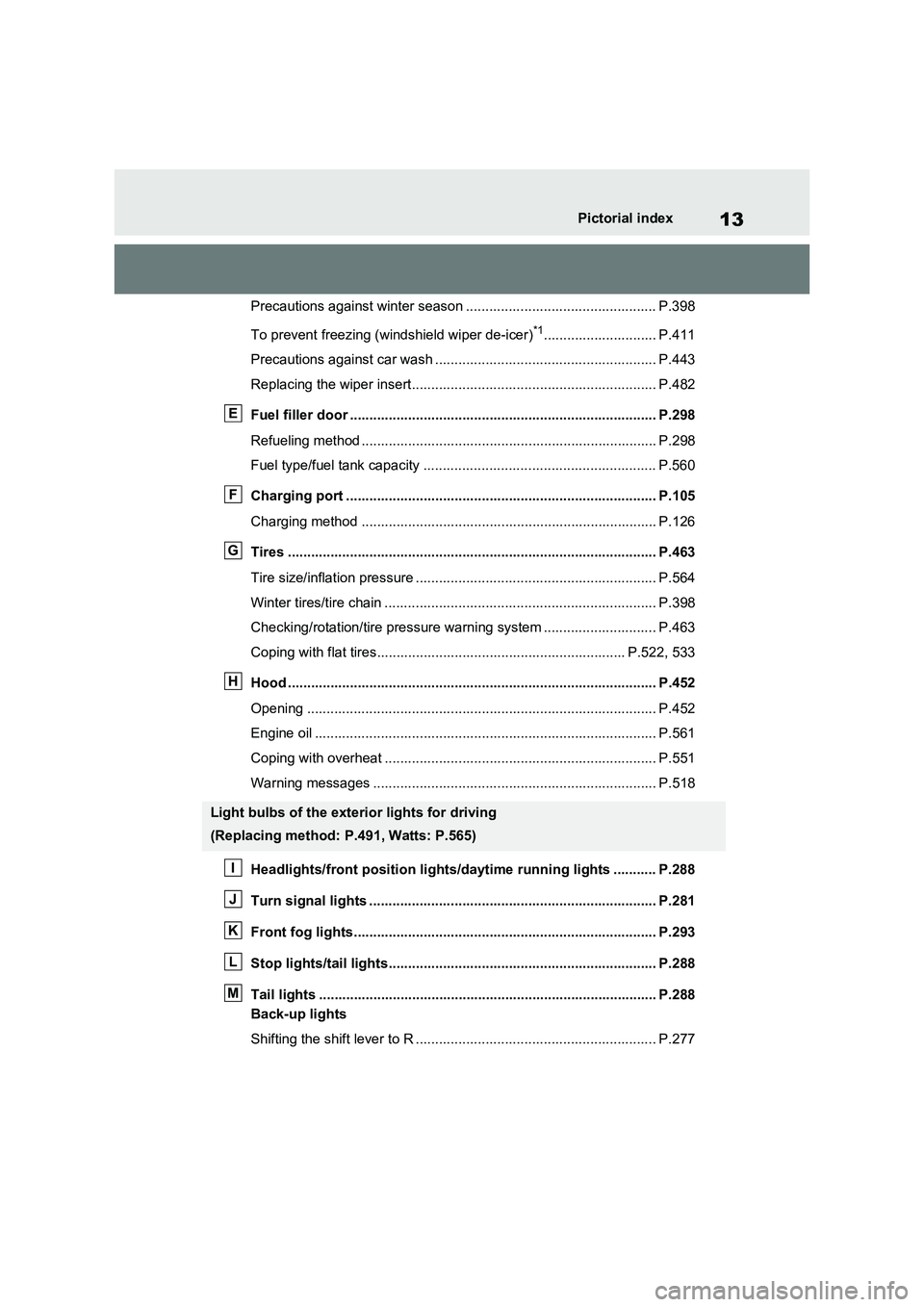
13Pictorial index
Precautions against winter season ................................................. P.398
To prevent freezing (windshield wiper de-icer)
*1............................. P.411
Precautions against car wash ......................................................... P.443
Replacing the wiper insert............................................................... P.482
Fuel filler door ............................................................................... P.298
Refueling method ............................................................................ P.298
Fuel type/fuel tank capacity ............................................................ P.560
Charging port ................................................................................ P.105
Charging method ............................................................................ P.126
Tires ............................................................................................... P.463
Tire size/inflation pressure .............................................................. P.564
Winter tires/tire chain ...................................................................... P.398
Checking/rotation/tire pressure warning system ............................. P.463
Coping with flat tires................................................................ P.522, 533
Hood ............................................................................................... P.452
Opening .......................................................................................... P.452
Engine oil ........................................................................................ P.561
Coping with overheat ...................................................................... P.551
Warning messages ......................................................................... P.518
Headlights/front position lights/daytime running lights ........... P.288
Turn signal lights .......................................................................... P.281
Front fog lights.............................................................................. P.293
Stop lights/tail lights..................................................................... P.288
Tail lights ....................................................................................... P.288
Back-up lights
Shifting the shift lever to R .............................................................. P.277
Light bulbs of the exterior lights for driving
(Replacing method: P.491, Watts: P.565)
E
F
G
H
I
J
K
L
M
Page 43 of 662
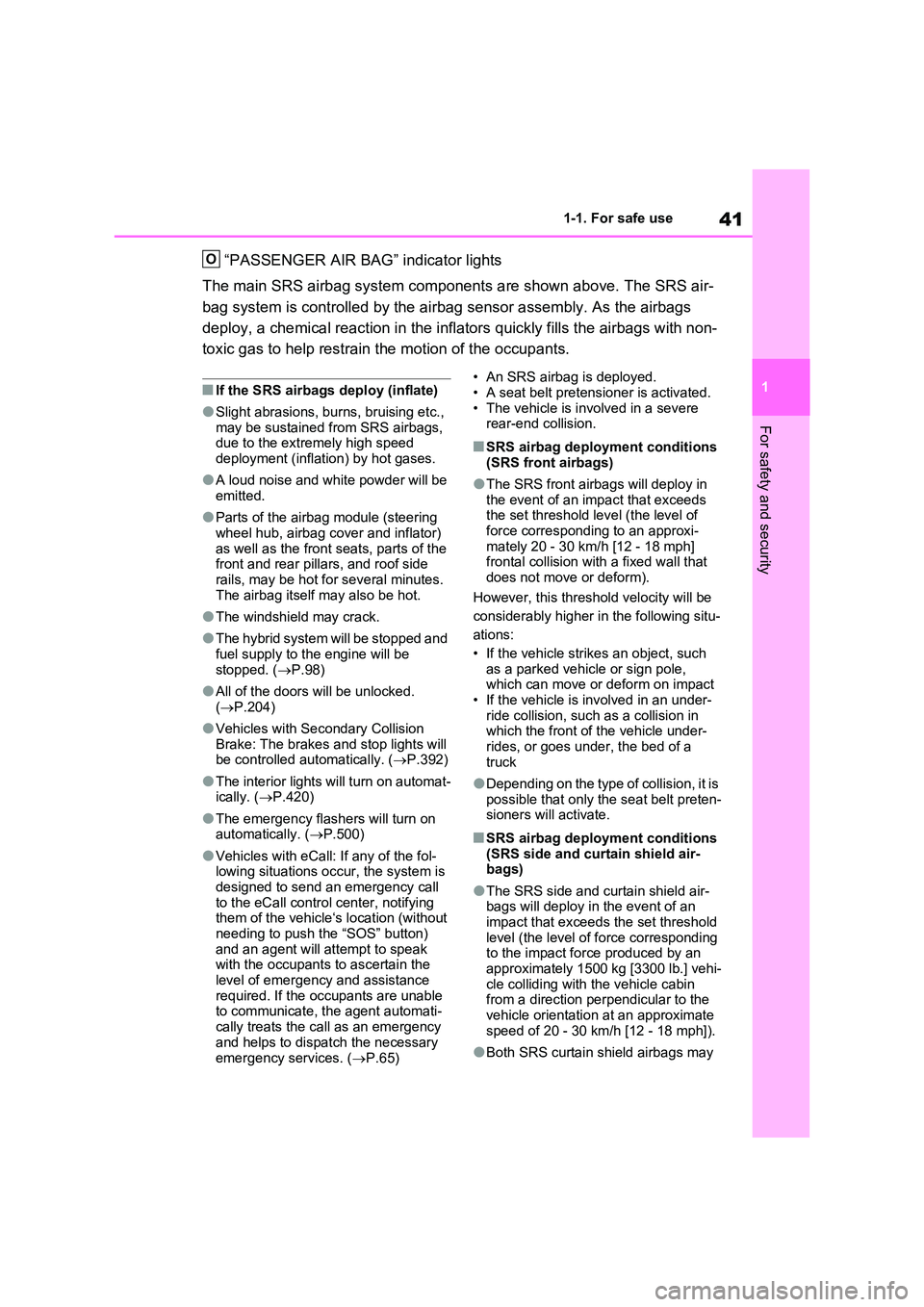
41
1
1-1. For safe use
For safety and security
“PASSENGER AIR BAG” indicator lights
The main SRS airbag system components are shown above. The SRS air-
bag system is controlled by the airbag sensor assembly. As the airbags
deploy, a chemical reaction in the inflators quickly fills the airbags with non-
toxic gas to help restrain the motion of the occupants.
�QIf the SRS airbags deploy (inflate)
�OSlight abrasions, burns, bruising etc., may be sustained from SRS airbags, due to the extremely high speed
deployment (inflation) by hot gases.
�OA loud noise and white powder will be
emitted.
�OParts of the airbag module (steering
wheel hub, airbag cover and inflator) as well as the front seats, parts of the front and rear pillars, and roof side
rails, may be hot for several minutes. The airbag itself may also be hot.
�OThe windshield may crack.
�OThe hybrid system will be stopped and
fuel supply to the engine will be stopped. ( P.98)
�OAll of the doors will be unlocked. ( P.204)
�OVehicles with Secondary Collision Brake: The brakes and stop lights will be controlled automatically. ( P.392)
�OThe interior lights will turn on automat- ically. ( P.420)
�OThe emergency flashers will turn on automatically. ( P.500)
�OVehicles with eCall: If any of the fol- lowing situations occur, the system is
designed to send an emergency call to the eCall control center, notifying them of the vehicle‘s location (without
needing to push the “SOS” button) and an agent will attempt to speak with the occupants to ascertain the
level of emergency and assistance required. If the occupants are unable to communicate, the agent automati-
cally treats the call as an emergency and helps to dispatch the necessary
emergency services. ( P.65)
• An SRS airbag is deployed. • A seat belt pretensioner is activated.
• The vehicle is involved in a severe rear-end collision.
�QSRS airbag deployment conditions
(SRS front airbags)
�OThe SRS front airbags will deploy in
the event of an impact that exceeds the set threshold level (the level of force corresponding to an approxi-
mately 20 - 30 km/h [12 - 18 mph] frontal collision with a fixed wall that does not move or deform).
However, this threshold velocity will be
considerably higher in the following situ-
ations:
• If the vehicle strikes an object, such as a parked vehicle or sign pole, which can move or deform on impact
• If the vehicle is involved in an under- ride collision, such as a collision in which the front of the vehicle under-
rides, or goes under, the bed of a truck
�ODepending on the type of collision, it is possible that only the seat belt preten-sioners will activate.
�QSRS airbag deployment conditions
(SRS side and curtain shield air- bags)
�OThe SRS side and curtain shield air-bags will deploy in the event of an impact that exceeds the set threshold
level (the level of force corresponding to the impact force produced by an approximately 1500 kg [3300 lb.] vehi-
cle colliding with the vehicle cabin from a direction perpendicular to the vehicle orientation at an approximate
speed of 20 - 30 km/h [12 - 18 mph]).
�OBoth SRS curtain shield airbags may
O
Page 106 of 662
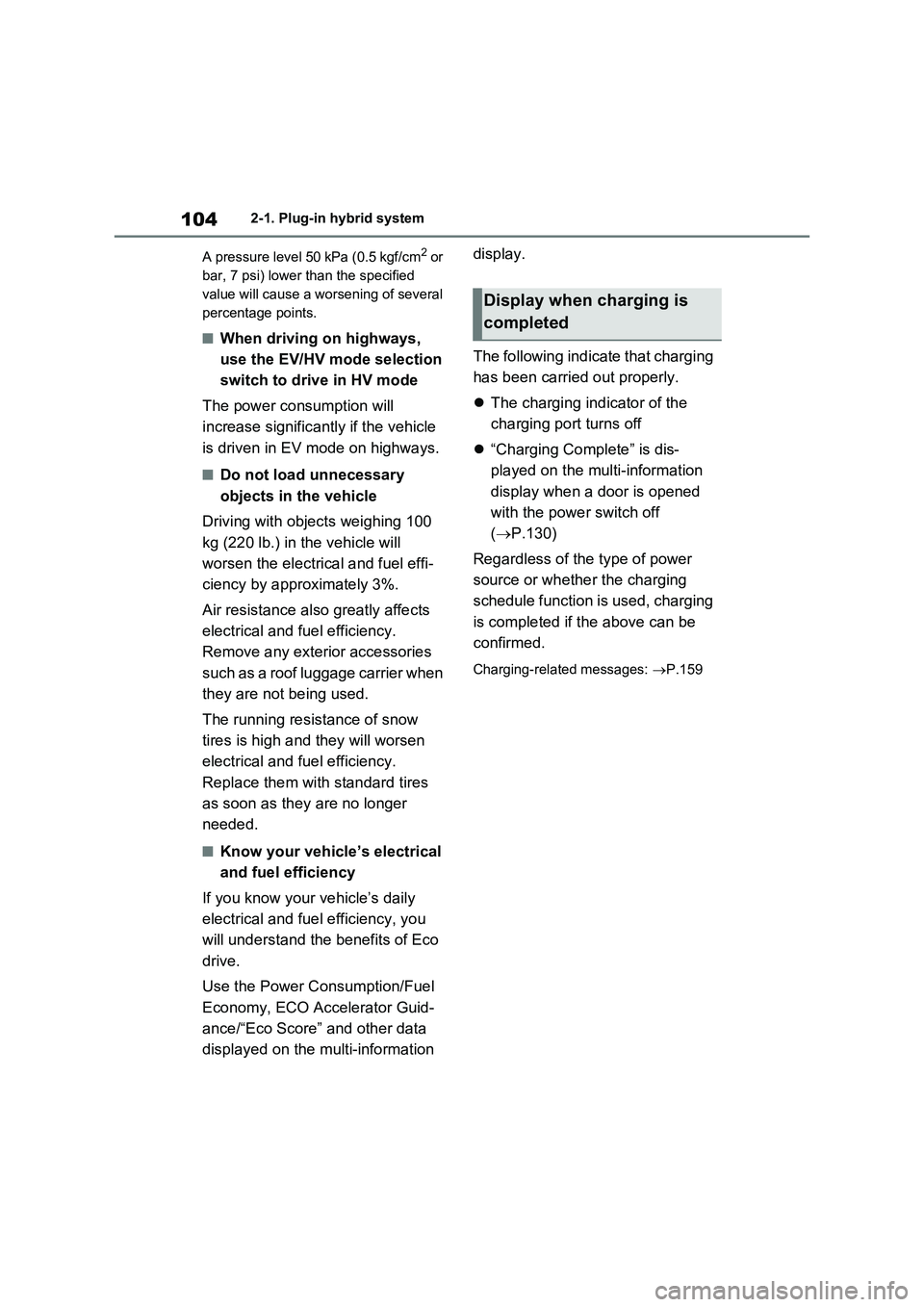
1042-1. Plug-in hybrid system
A pressure level 50 kPa (0.5 kgf/cm
2 or
bar, 7 psi) lower than the specified
value will cause a worsening of several
percentage points.
�QWhen driving on highways,
use the EV/HV mode selection
switch to drive in HV mode
The power consumption will
increase significantly if the vehicle
is driven in EV mode on highways.
�QDo not load unnecessary
objects in the vehicle
Driving with objects weighing 100
kg (220 lb.) in the vehicle will
worsen the electrical and fuel effi-
ciency by approximately 3%.
Air resistance also greatly affects
electrical and fuel efficiency.
Remove any exterior accessories
such as a roof luggage carrier when
they are not being used.
The running resistance of snow
tires is high and they will worsen
electrical and fuel efficiency.
Replace them with standard tires
as soon as they are no longer
needed.
�QKnow your vehicle’s electrical
and fuel efficiency
If you know your vehicle’s daily
electrical and fuel efficiency, you
will understand the benefits of Eco
drive.
Use the Power Consumption/Fuel
Economy, ECO Accelerator Guid-
ance/“Eco Score” and other data
displayed on the multi-information display.
The following indicate that charging
has been carried out properly.
The charging indicator of the
charging port turns off
“Charging Complete” is dis-
played on the multi-information
display when a door is opened
with the power switch off
(P.130)
Regardless of the type of power
source or whether the charging
schedule function is used, charging
is completed if the above can be
confirmed.
Charging-related messages: P.159
Display when charging is
completed
Page 174 of 662
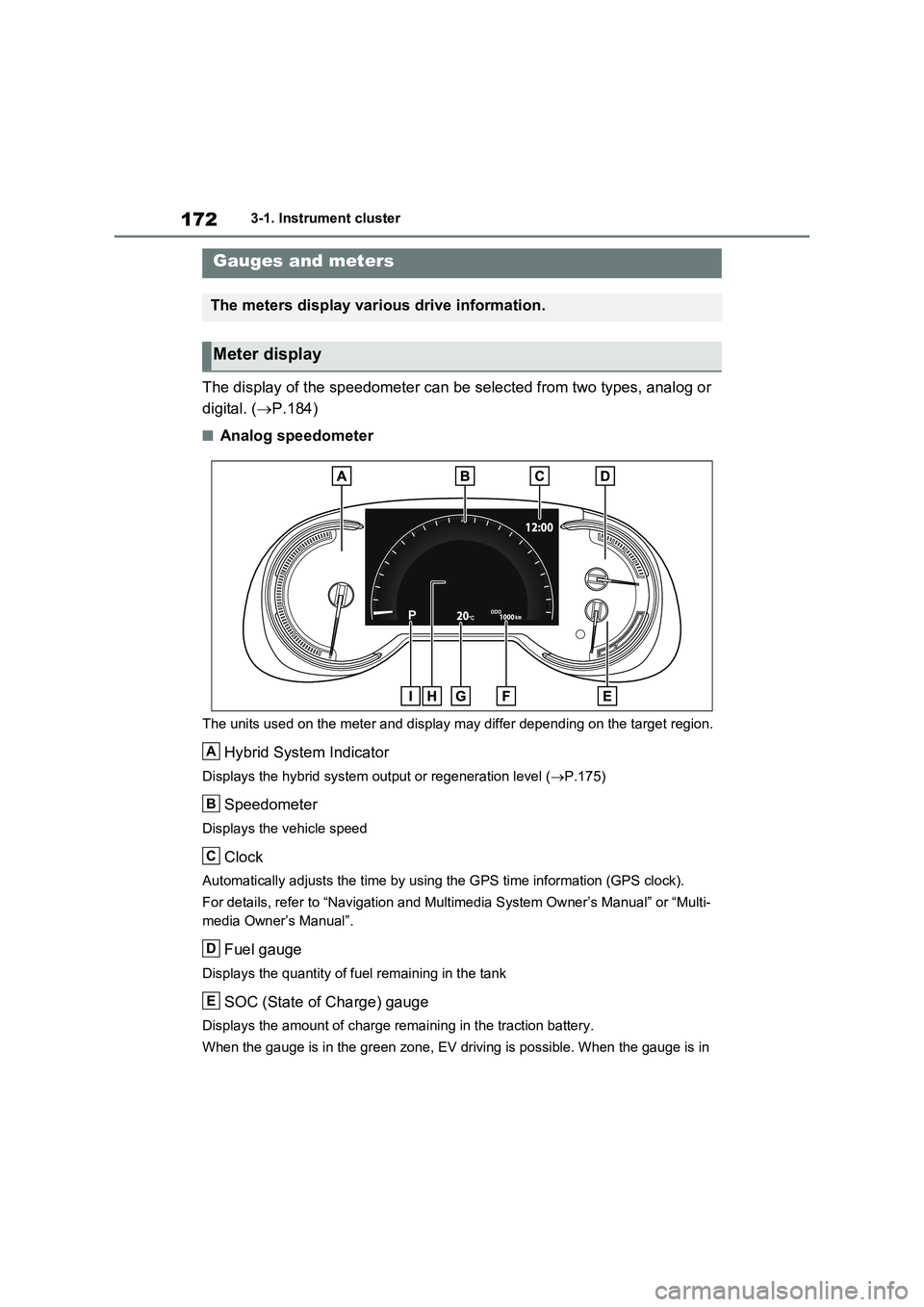
1723-1. Instrument cluster
The display of the speedometer can be selected from two types, analog or
digital. ( P.184)
�QAnalog speedometer
The units used on the meter and display may differ depending on the target region.
Hybrid System Indicator
Displays the hybrid system output or regeneration level (P.175)
Speedometer
Displays the vehicle speed
Clock
Automatically adjusts the time by using the GPS time information (GPS clock).
For details, refer to “Navigation and Multimedia System Owner’s Manual” or “Multi-
media Owner’s Manual”.
Fuel gauge
Displays the quantity of fuel remaining in the tank
SOC (State of Charge) gauge
Displays the amount of charge remaining in the traction battery.
When the gauge is in the green zone, EV driving is possible. When the gauge is in
Gauges and meters
The meters display various drive information.
Meter display
A
B
C
D
E
Page 179 of 662
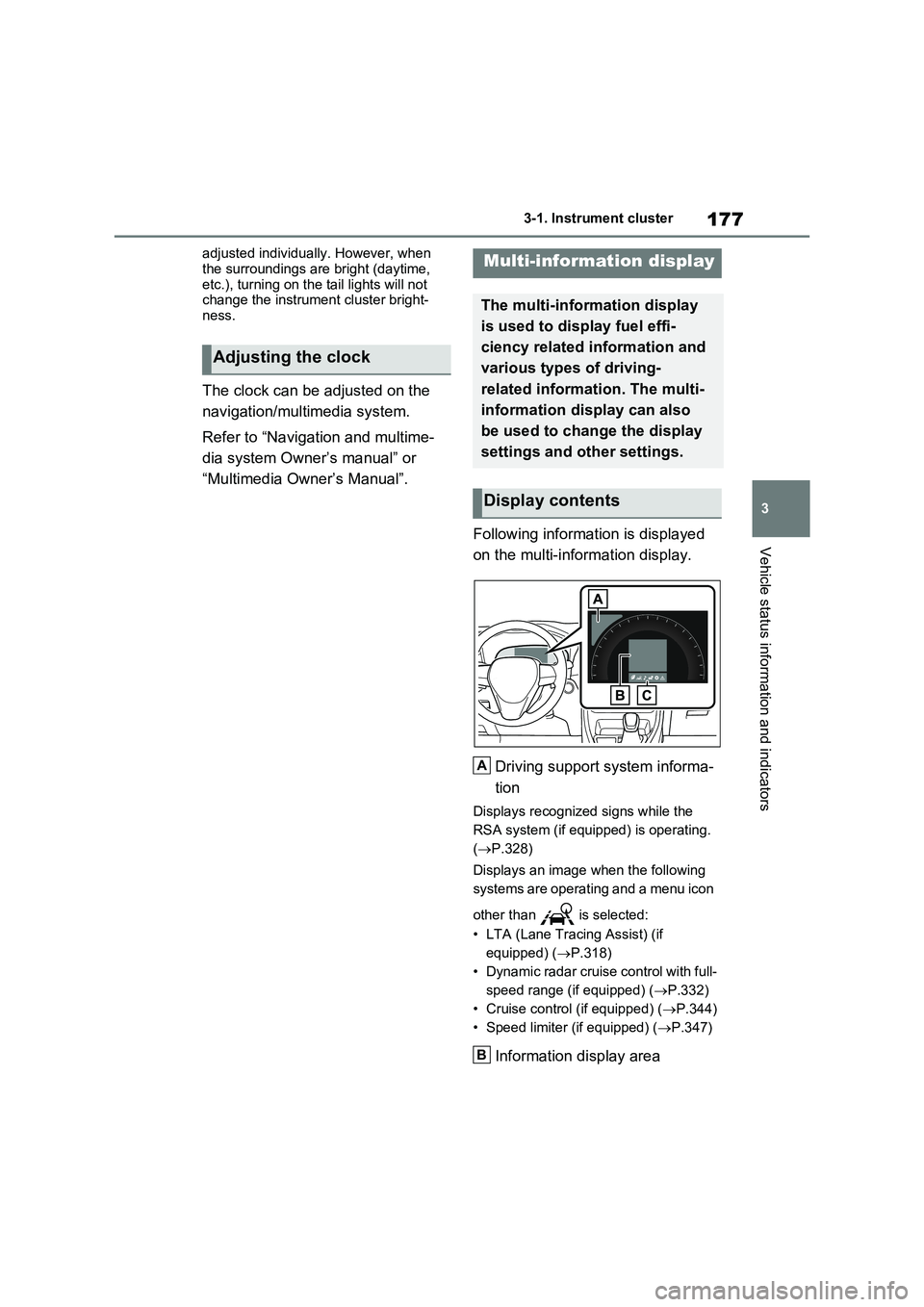
177
3
3-1. Instrument cluster
Vehicle status information and indicators
adjusted individually. However, when
the surroundings are bright (daytime, etc.), turning on the tail lights will not change the instrument cluster bright-
ness.
The clock can be adjusted on the
navigation/multimedia system.
Refer to “Navigation and multime-
dia system Owner’s manual” or
“Multimedia Owner’s Manual”.
Following information is displayed
on the multi-information display.
Driving support system informa-
tion
Displays recognized signs while the
RSA system (if equipped) is operating.
( P.328)
Displays an image when the following
systems are operating and a menu icon
other than is selected:
• LTA (Lane Tracing Assist) (if
equipped) ( P.318)
• Dynamic radar cruise control with full-
speed range (if equipped) ( P.332)
• Cruise control (if equipped) ( P.344)
• Speed limiter (if equipped) ( P.347)
Information display area
Adjusting the clock
Multi-information display
The multi-information display
is used to display fuel effi-
ciency related information and
various types of driving-
related information. The multi-
information display can also
be used to change the display
settings and other settings.
Display contents
A
B
Page 188 of 662
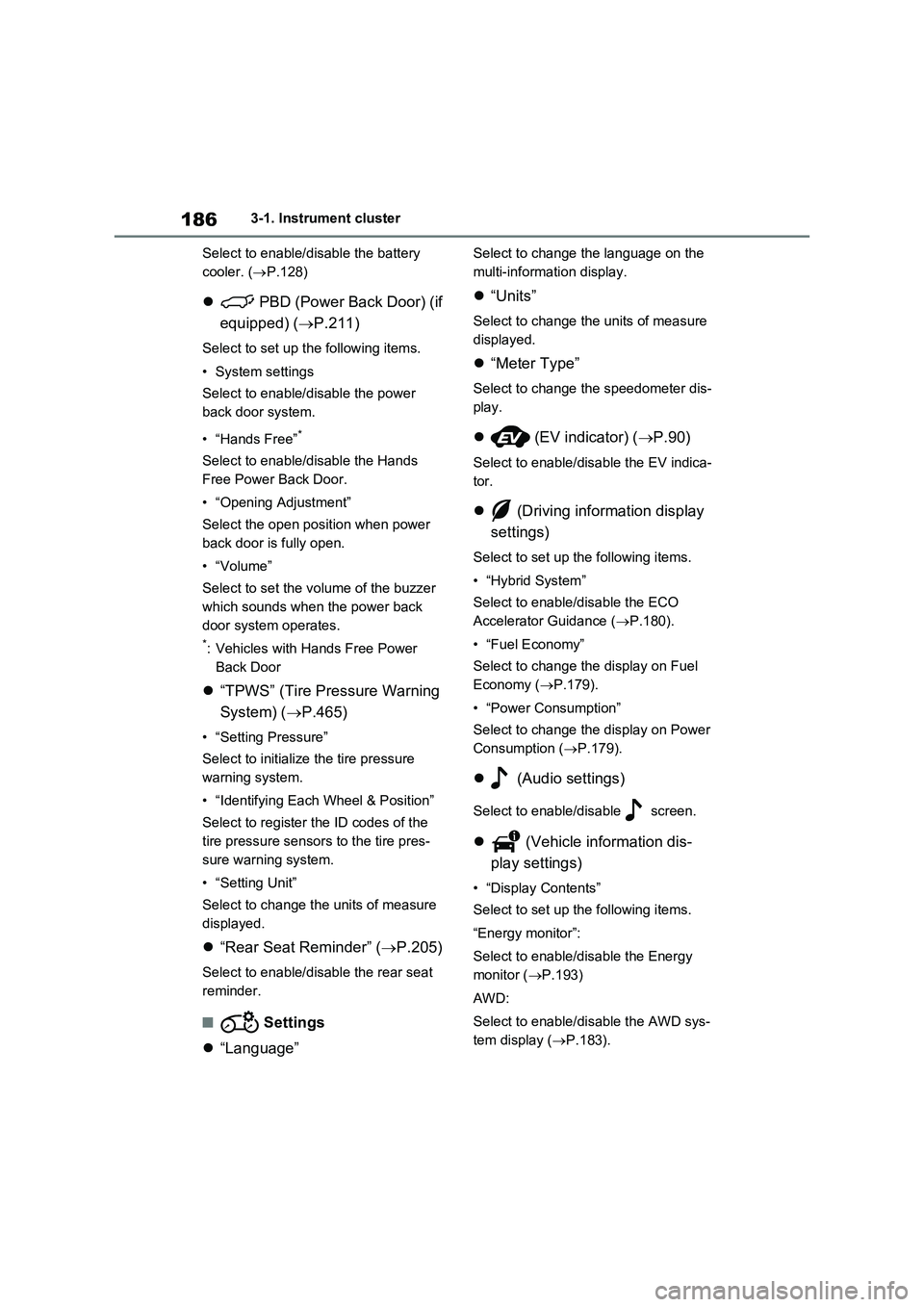
1863-1. Instrument cluster
Select to enable/disable the battery
cooler. (P.128)
PBD (Power Back Door) (if
equipped) (P.211)
Select to set up the following items.
•System settings
Select to enable/disable the power
back door system.
•“Hands Free”
*
Select to enable/disable the Hands
Free Power Back Door.
• “Opening Adjustment”
Select the open position when power
back door is fully open.
•“Volume”
Select to set the volume of the buzzer
which sounds when the power back
door system operates.
*: Vehicles with Hands Free Power
Back Door
“TPWS” (Tire Pressure Warning
System) (P.465)
• “Setting Pressure”
Select to initialize the tire pressure
warning system.
• “Identifying Each Wheel & Position”
Select to register the ID codes of the
tire pressure sensors to the tire pres-
sure warning system.
•“Setting Unit”
Select to change the units of measure
displayed.
“Rear Seat Reminder” (P.205)
Select to enable/disable the rear seat
reminder.
�Q Settings
“Language”
Select to change the language on the
multi-information display.
“Units”
Select to change the units of measure
displayed.
“Meter Type”
Select to change the speedometer dis-
play.
(EV indicator) (P.90)
Select to enable/disable the EV indica-
tor.
(Driving information display
settings)
Select to set up the following items.
•“Hybrid System”
Select to enable/disable the ECO
Accelerator Guidance (P.180).
• “Fuel Economy”
Select to change the display on Fuel
Economy (P.179).
• “Power Consumption”
Select to change the display on Power
Consumption (P.179).
(Audio settings)
Select to enable/disable screen.
(Vehicle information dis-
play settings)
• “Display Contents”
Select to set up the following items.
“Energy monitor”:
Select to enable/disable the Energy
monitor (P.193)
AWD:
Select to enable/disable the AWD sys-
tem display (P.183).
Page 300 of 662
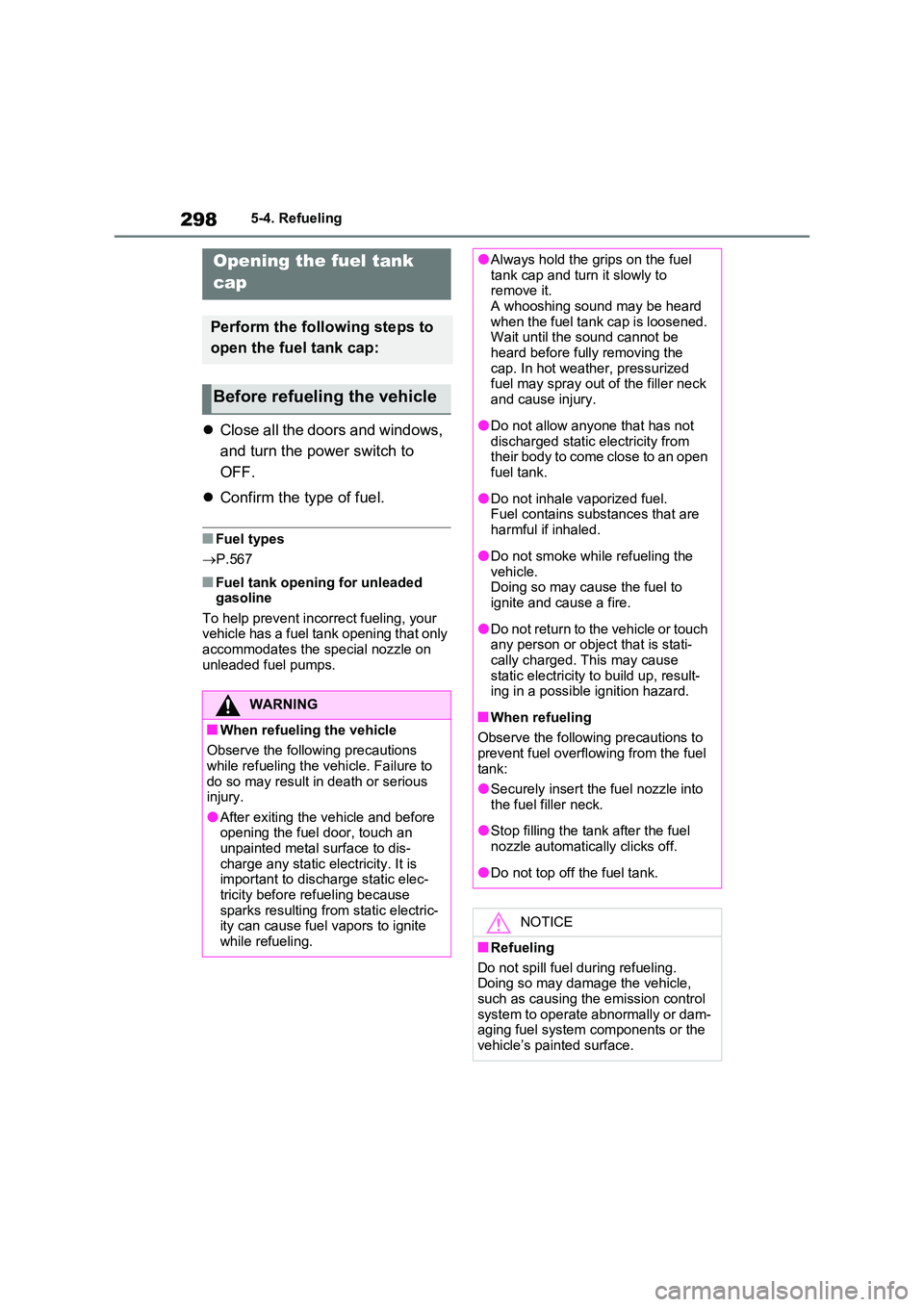
2985-4. Refueling
5-4.Refuelin g
Close all the doors and windows,
and turn the power switch to
OFF.
Confirm the type of fuel.
�QFuel types
P.567
�QFuel tank opening for unleaded gasoline
To help prevent incorrect fueling, your vehicle has a fuel tank opening that only accommodates the special nozzle on
unleaded fuel pumps.
Opening the fuel tank
cap
Perform the following steps to
open the fuel tank cap:
Before refueling the vehicle
WARNING
�QWhen refueling the vehicle
Observe the following precautions
while refueling the vehicle. Failure to do so may result in death or serious injury.
�OAfter exiting the vehicle and before opening the fuel door, touch an unpainted metal surface to dis-
charge any static electricity. It is important to discharge static elec-tricity before refueling because
sparks resulting from static electric- ity can cause fuel vapors to ignite while refueling.
�OAlways hold the grips on the fuel tank cap and turn it slowly to remove it.
A whooshing sound may be heard when the fuel tank cap is loosened. Wait until the sound cannot be
heard before fully removing the cap. In hot weather, pressurized fuel may spray out of the filler neck
and cause injury.
�ODo not allow anyone that has not
discharged static electricity from their body to come close to an open fuel tank.
�ODo not inhale vaporized fuel.Fuel contains substances that are
harmful if inhaled.
�ODo not smoke while refueling the
vehicle. Doing so may cause the fuel to ignite and cause a fire.
�ODo not return to the vehicle or touch any person or object that is stati-
cally charged. This may cause static electricity to build up, result-ing in a possible ignition hazard.
�QWhen refueling
Observe the following precautions to
prevent fuel overflowing from the fuel tank:
�OSecurely insert the fuel nozzle into
the fuel filler neck.
�OStop filling the tank after the fuel
nozzle automatically clicks off.
�ODo not top off the fuel tank.
NOTICE
�QRefueling
Do not spill fuel during refueling. Doing so may damage the vehicle,
such as causing the emission control system to operate abnormally or dam-aging fuel system components or the
vehicle’s painted surface.
Page 393 of 662
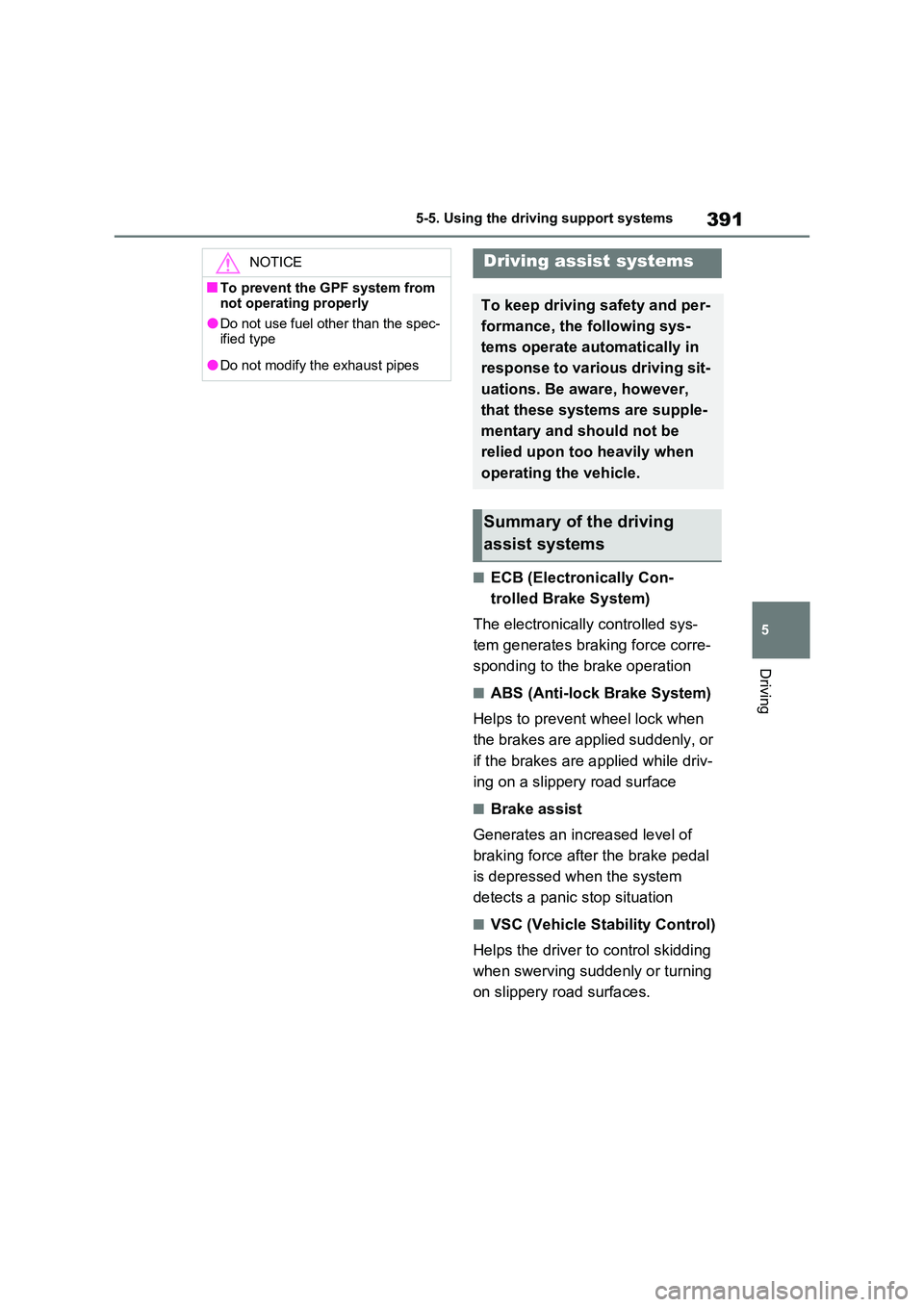
391
5
5-5. Using the driving support systems
Driving
�QECB (Electronically Con-
trolled Brake System)
The electronically controlled sys-
tem generates braking force corre-
sponding to the brake operation
�QABS (Anti-lock Brake System)
Helps to prevent wheel lock when
the brakes are applied suddenly, or
if the brakes are applied while driv-
ing on a slippery road surface
�QBrake assist
Generates an increased level of
braking force after the brake pedal
is depressed when the system
detects a panic stop situation
�QVSC (Vehicle Stability Control)
Helps the driver to control skidding
when swerving suddenly or turning
on slippery road surfaces.
NOTICE
�QTo prevent the GPF system from not operating properly
�ODo not use fuel other than the spec-ified type
�ODo not modify the exhaust pipes
Driving assist systems
To keep driving safety and per-
formance, the following sys-
tems operate automatically in
response to various driving sit-
uations. Be aware, however,
that these systems are supple-
mentary and should not be
relied upon too heavily when
operating the vehicle.
Summary of the driving
assist systems
Page 402 of 662
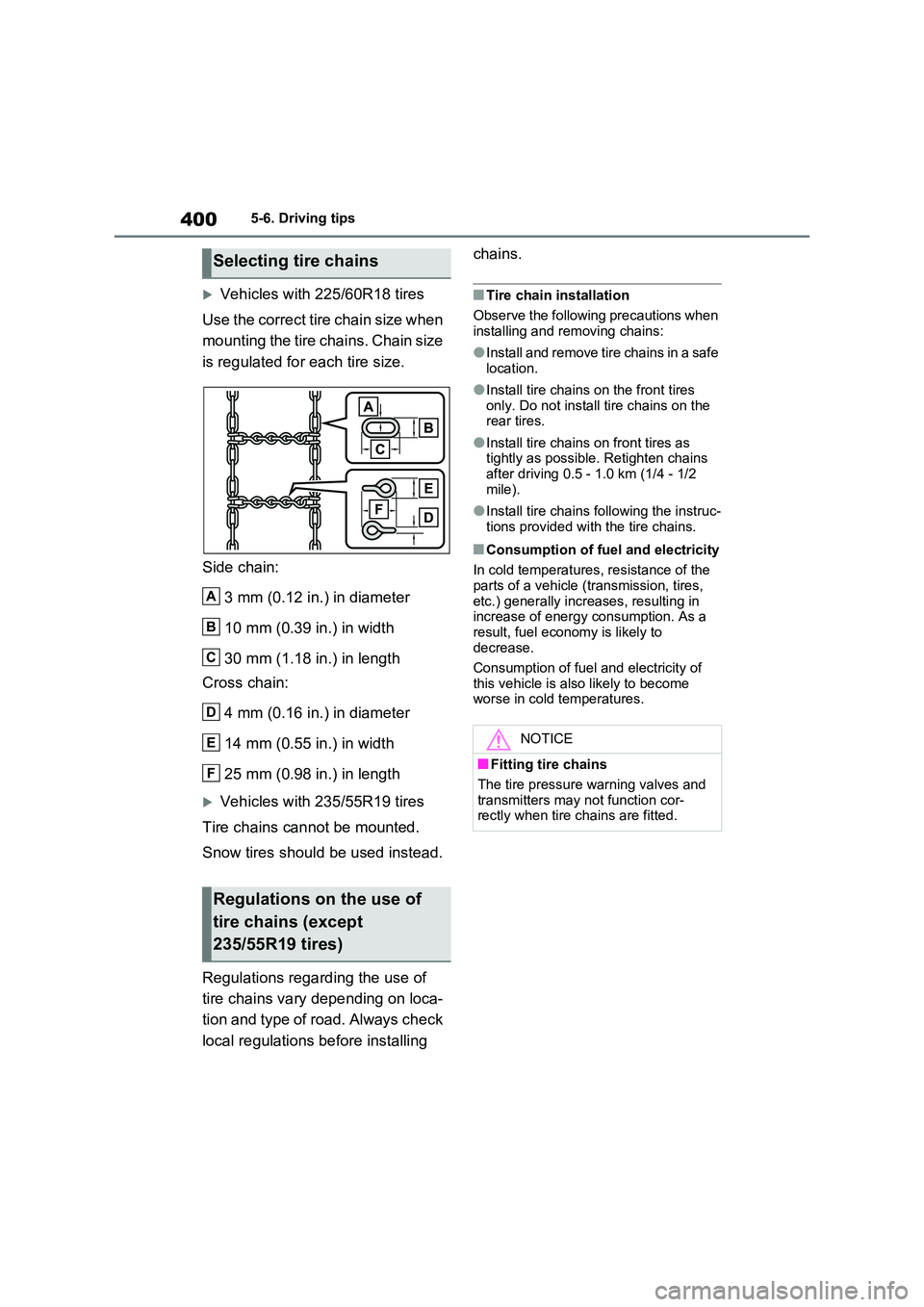
4005-6. Driving tips
Vehicles with 225/60R18 tires
Use the correct tire chain size when
mounting the tire chains. Chain size
is regulated for each tire size.
Side chain:
3 mm (0.12 in.) in diameter
10 mm (0.39 in.) in width
30 mm (1.18 in.) in length
Cross chain:
4 mm (0.16 in.) in diameter
14 mm (0.55 in.) in width
25 mm (0.98 in.) in length
Vehicles with 235/55R19 tires
Tire chains cannot be mounted.
Snow tires should be used instead.
Regulations regarding the use of
tire chains vary depending on loca-
tion and type of road. Always check
local regulations before installing
chains.
�QTire chain installation
Observe the following precautions when installing and removing chains:
�OInstall and remove tire chains in a safe location.
�OInstall tire chains on the front tires only. Do not install tire chains on the rear tires.
�OInstall tire chains on front tires as tightly as possible. Retighten chains
after driving 0.5 - 1.0 km (1/4 - 1/2 mile).
�OInstall tire chains following the instruc-tions provided with the tire chains.
�QConsumption of fuel and electricity
In cold temperatures, resistance of the
parts of a vehicle (transmission, tires, etc.) generally increases, resulting in increase of energy consumption. As a
result, fuel economy is likely to decrease.
Consumption of fuel and electricity of
this vehicle is also likely to become worse in cold temperatures.
Selecting tire chains
Regulations on the use of
tire chains (except
235/55R19 tires)
A
B
C
D
E
F
NOTICE
�QFitting tire chains
The tire pressure warning valves and transmitters may not function cor-rectly when tire chains are fitted.
Page 543 of 662
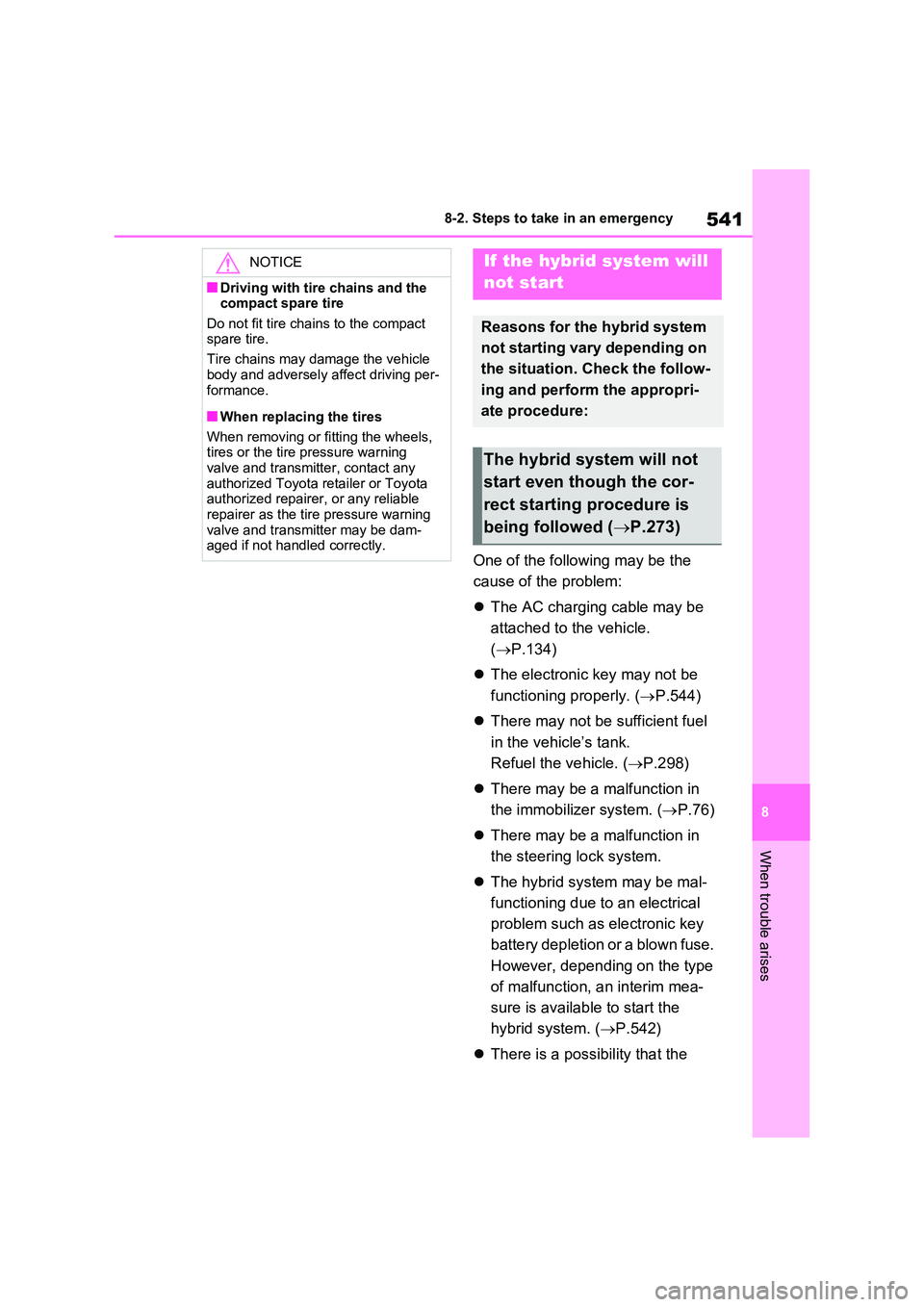
541
8
8-2. Steps to take in an emergency
When trouble arises
One of the following may be the
cause of the problem:
The AC charging cable may be
attached to the vehicle.
( P.134)
The electronic key may not be
functioning properly. ( P.544)
There may not be sufficient fuel
in the vehicle’s tank.
Refuel the vehicle. ( P.298)
There may be a malfunction in
the immobilizer system. ( P.76)
There may be a malfunction in
the steering lock system.
The hybrid system may be mal-
functioning due to an electrical
problem such as electronic key
battery depletion or a blown fuse.
However, depending on the type
of malfunction, an interim mea-
sure is available to start the
hybrid system. ( P.542)
There is a possibility that the
NOTICE
�QDriving with tire chains and the compact spare tire
Do not fit tire chains to the compact spare tire.
Tire chains may damage the vehicle
body and adversely affect driving per- formance.
�QWhen replacing the tires
When removing or fitting the wheels, tires or the tire pressure warning
valve and transmitter, contact any authorized Toyota retailer or Toyota authorized repairer, or any reliable
repairer as the tire pressure warning valve and transmitter may be dam-aged if not handled correctly.
If the hybrid system will
not start
Reasons for the hybrid system
not starting vary depending on
the situation. Check the follow-
ing and perform the appropri-
ate procedure:
The hybrid system will not
start even though the cor-
rect starting procedure is
being followed ( P.273)